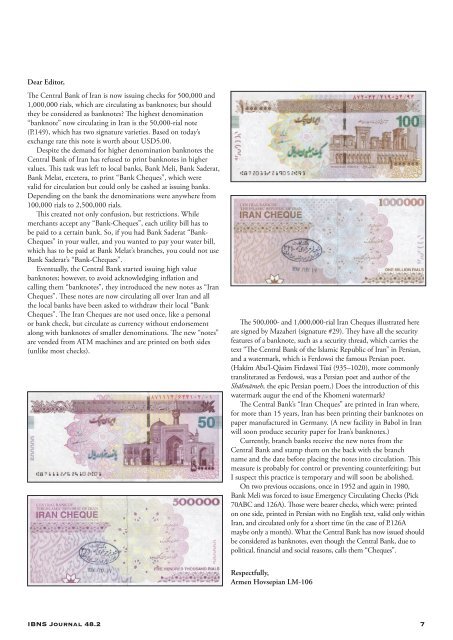You also want an ePaper? Increase the reach of your titles
YUMPU automatically turns print PDFs into web optimized ePapers that Google loves.
Dear Editor,<br />
The Central Bank of Iran is now issuing checks for 500,000 and<br />
1,000,000 rials, which are circulating as banknotes; but should<br />
they be considered as banknotes? The highest denomination<br />
“banknote” now circulating in Iran is the 50,000-rial note<br />
(P.149), which has two signature varieties. Based on today’s<br />
exchange rate this note is worth about USD5.00.<br />
Despite the demand for higher denomination banknotes the<br />
Central Bank of Iran has refused to print banknotes in higher<br />
values. This task was left to local banks, Bank Meli, Bank Saderat,<br />
Bank Melat, etcetera, to print “Bank Cheques”, which were<br />
valid for circulation but could only be cashed at issuing banks.<br />
Depending on the bank the denominations were anywhere from<br />
100,000 rials to 2,500,000 rials.<br />
This created not only confusion, but restrictions. While<br />
merchants accept any “Bank-Cheques”, each utility bill has to<br />
be paid to a certain bank. So, if you had Bank Saderat “Bank-<br />
Cheques” in your wallet, and you wanted to pay your water bill,<br />
which has to be paid at Bank Melat’s branches, you could not use<br />
Bank Saderat’s “Bank-Cheques”.<br />
Eventually, the Central Bank started issuing high value<br />
banknotes; however, to avoid acknowledging inflation and<br />
calling them “banknotes”, they introduced the new notes as “Iran<br />
Cheques”. These notes are now circulating all over Iran and all<br />
the local banks have been asked to withdraw their local “Bank<br />
Cheques”. The Iran Cheques are not used once, like a personal<br />
or bank check, but circulate as currency without endorsement<br />
along with banknotes of smaller denominations. The new “notes”<br />
are vended from ATM machines and are printed on both sides<br />
(unlike most checks).<br />
The 500,000- and 1,000,000-rial Iran Cheques illustrated here<br />
are signed by Mazaheri (signature #29). They have all the security<br />
features of a banknote, such as a security thread, which carries the<br />
text “The Central Bank of the Islamic Republic of Iran” in Persian,<br />
and a watermark, which is Ferdowsi the famous Persian poet.<br />
(Hakīm Abu’l-Qāsim Firdawsī Tūsī (935–1020), more commonly<br />
transliterated as Ferdowsi, was a Persian poet and author of the<br />
Shāhnāmeh, the epic Persian poem.) Does the introduction of this<br />
watermark augur the end of the Khomeni watermark?<br />
The Central Bank’s “Iran Cheques” are printed in Iran where,<br />
for more than 15 years, Iran has been printing their banknotes on<br />
paper manufactured in Germany. (A new facility in Babol in Iran<br />
will soon produce security paper for Iran’s banknotes.)<br />
Currently, branch banks receive the new notes from the<br />
Central Bank and stamp them on the back with the branch<br />
name and the date before placing the notes into circulation. This<br />
measure is probably for control or preventing counterfeiting; but<br />
I suspect this practice is temporary and will soon be abolished.<br />
On two previous occasions, once in 1952 and again in 1980,<br />
Bank Meli was forced to issue Emergency Circulating Checks (Pick<br />
70ABC and 126A). Those were bearer checks, which were: printed<br />
on one side, printed in Persian with no English text, valid only within<br />
Iran, and circulated only for a short time (in the case of P.126A<br />
maybe only a month). What the Central Bank has now issued should<br />
be considered as banknotes, even though the Central Bank, due to<br />
political, financial and social reasons, calls them “Cheques”.<br />
Respectfully,<br />
Armen Hovsepian LM-106<br />
<strong>IBNS</strong> Journal 48.2 7


